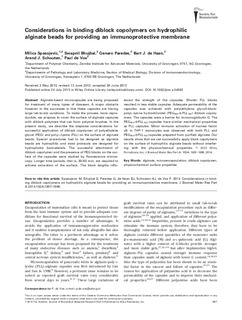| dc.contributor.author | Bhujbal, Swapnil Vilas | |
| dc.contributor.author | Spasojevic, Milica | |
| dc.contributor.author | Paredes-Juarez, Genaro | |
| dc.contributor.author | de Haan, Bart | |
| dc.contributor.author | Schouten, Arend J | |
| dc.contributor.author | De Vos, Paul | |
| dc.date.accessioned | 2017-12-02T10:32:34Z | |
| dc.date.available | 2017-12-02T10:32:34Z | |
| dc.date.created | 2017-12-01T11:19:50Z | |
| dc.date.issued | 2014 | |
| dc.identifier.issn | 1549-3296 | |
| dc.identifier.uri | http://hdl.handle.net/11250/2468828 | |
| dc.description.abstract | Alginate-based microcapsules are being proposed for treatment of many types of diseases. A major obstacle however in the successes is that these capsules are having large lab-to-lab variations. To make the process more reproducible, we propose to cover the surface of alginate capsules with diblock polymers that can form polymer brushes. In the present study, we describe the stepwise considerations for successful application of diblock copolymer of polyethylene glycol (PEG) and poly-L-lysine (PLL) on the surface of alginate beads. Special procedures had to be designed as alginate beads are hydrophilic and most protocols are designed for hydrophobic biomaterials. The successful attachment of diblock copolymer and the presence of PEG blocks on the surface of the capsules were studied by fluorescence microscopy. Longer time periods, that is, 30–60 min, are required to achieve saturation of the surface. The block lengths influenced the strength of the capsules. Shorter PLL blocks resulted in less stable capsules. Adequate permeability of the capsules was achieved with poly(ethylene glycol)-block-poly(L-lysine hydrochloride) (PEG454-b-PLL100) diblock copolymers. The capsules were a barrier for immunoglobulin G. The PEG454-b-PLL100 capsules have similar mechanical properties as PLL capsules. Minor immune activation of nuclear factor κB in THP-1 monocytes was observed with both PLL and PEG454-b-PLL100 capsules prepared from purified alginate. Our results show that we can successfully apply block copolymers on the surface of hydrophilic alginate beads without interfering with the physicochemical properties. © 2013 Wiley Periodicals, Inc. J Biomed Mater Res Part A: 102A: 1887–1896, 2014. | nb_NO |
| dc.language.iso | eng | nb_NO |
| dc.publisher | Wiley | nb_NO |
| dc.rights | Navngivelse-Ikkekommersiell 4.0 Internasjonal | * |
| dc.rights.uri | http://creativecommons.org/licenses/by-nc/4.0/deed.no | * |
| dc.title | Considerations in binding diblock copolymers on hydrophilic alginate beads for providing an immunoprotective membrane. | nb_NO |
| dc.type | Journal article | nb_NO |
| dc.type | Peer reviewed | nb_NO |
| dc.description.version | publishedVersion | nb_NO |
| dc.source.journal | Journal of Biomedical Materials Research. Part A | nb_NO |
| dc.identifier.doi | 10.1002/jbm.a.34863. | |
| dc.identifier.cristin | 1521494 | |
| dc.description.localcode | Copyright © 2013 The Authors. Journal of Biomedical Materials Research Part A Published by Wiley Periodicals, Inc. This is an open access article under the terms of the Creative Commons Attribution-NonCommercial License, which permits use, distribution and reproduction in any medium, provided the original work is properly cited and is not used for commercial purposes. | nb_NO |
| cristin.unitcode | 194,66,15,0 | |
| cristin.unitname | Institutt for bioteknologi og matvitenskap | |
| cristin.ispublished | true | |
| cristin.fulltext | original | |
| cristin.qualitycode | 1 | |

